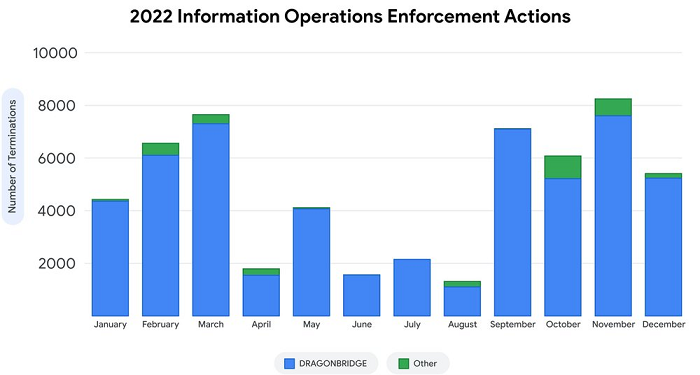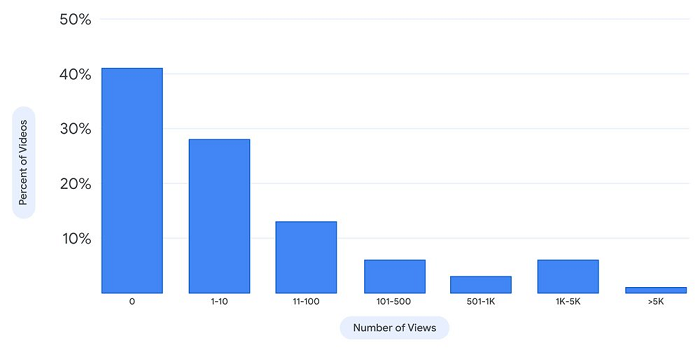SOCIAL
Google Outlines Ongoing Efforts to Combat China-Based Influence Operations Targeting Social Apps

Over the past year, Google has repeatedly noted that a China-based group has been looking to use YouTube, in particular, to influence western audiences, by building various channels in the app, then seeding them with pro-China content.
There’s limited info available on the full origins or intentions of the group, but today, Google has published a new overview of its ongoing efforts to combat the initiative, called DRAGONBRIDGE.
As explained by Google:
“In 2022, Google disrupted over 50,000 instances of DRAGONBRIDGE activity across YouTube, Blogger, and AdSense, reflecting our continued focus on this actor and success in scaling our detection efforts across Google products. We have terminated over 100,000 DRAGONBRIDGE accounts in the IO network’s lifetime.”
As you can see in this chart, DRAGONBRIDGE is by far the most prolific source of coordinated information operations that Google has detected over the past year, while Google also notes that it’s been able to disrupt most of the project’s attempted influence, by snuffing out its content before it gets seen.

Worth noting the scale too – as Google notes, DRAGONBRIDGE has created more than 100,000 accounts, which includes tens of thousands of YouTube channels. Not individual videos, entire channels in the app, which is a huge amount of work, and content, that this group is producing.
That can’t be cheap, or easy to keep running. So they must be doing it for a reason.
The broader implication, which has been noted by various other publications and analysts, is that DRAGONBRIDGE is potentially being supported by the Chinese Government, as part of a broader effort to influence foreign policy approaches via social media apps.
Which, at this kind of scale, is a concern, while DRAGONBRIDGE has also targeted Facebook and Twitter as well, at different times, and it could be that their efforts on those platforms are also reaching similar activity levels, and may not have been detected as yet.
Which then also relates to TikTok, a Chinese-owned app that now has massive influence over younger audiences in western nations. If programs like this are already in effect, it stands to reason that TikTok is also likely a key candidate for boosting the same, which remains a key concern among regulators and officials in many nations.
The US Government is reportedly weighing a full TikTok ban, and if that happens, you can bet that many other nations will follow suit. Many government organizations are also banning TikTok on official devices, based on advice from security experts, and with programs like DRAGONBRIDGE also running, it does seem like Chinese-based groups are actively operating influence and manipulation programs in foreign nations.
Which seems like a significant issue, and while Google is seemingly catching most of these channels before they have an impact, it also seems likely that this is only one element of a larger push.
Hopefully, through collective action, the impact of such can be limited – but for TikTok, which still reports to Chinese ownership, it’s another element that could raise further questions and scrutiny.
SOCIAL
Snapchat Explores New Messaging Retention Feature: A Game-Changer or Risky Move?

In a recent announcement, Snapchat revealed a groundbreaking update that challenges its traditional design ethos. The platform is experimenting with an option that allows users to defy the 24-hour auto-delete rule, a feature synonymous with Snapchat’s ephemeral messaging model.
The proposed change aims to introduce a “Never delete” option in messaging retention settings, aligning Snapchat more closely with conventional messaging apps. While this move may blur Snapchat’s distinctive selling point, Snap appears convinced of its necessity.
According to Snap, the decision stems from user feedback and a commitment to innovation based on user needs. The company aims to provide greater flexibility and control over conversations, catering to the preferences of its community.
Currently undergoing trials in select markets, the new feature empowers users to adjust retention settings on a conversation-by-conversation basis. Flexibility remains paramount, with participants able to modify settings within chats and receive in-chat notifications to ensure transparency.
Snapchat underscores that the default auto-delete feature will persist, reinforcing its design philosophy centered on ephemerality. However, with the app gaining traction as a primary messaging platform, the option offers users a means to preserve longer chat histories.
The update marks a pivotal moment for Snapchat, renowned for its disappearing message premise, especially popular among younger demographics. Retaining this focus has been pivotal to Snapchat’s identity, but the shift suggests a broader strategy aimed at diversifying its user base.
This strategy may appeal particularly to older demographics, potentially extending Snapchat’s relevance as users age. By emulating features of conventional messaging platforms, Snapchat seeks to enhance its appeal and broaden its reach.
Yet, the introduction of message retention poses questions about Snapchat’s uniqueness. While addressing user demands, the risk of diluting Snapchat’s distinctiveness looms large.
As Snapchat ventures into uncharted territory, the outcome of this experiment remains uncertain. Will message retention propel Snapchat to new heights, or will it compromise the platform’s uniqueness?
Only time will tell.
SOCIAL
Catering to specific audience boosts your business, says accountant turned coach

While it is tempting to try to appeal to a broad audience, the founder of alcohol-free coaching service Just the Tonic, Sandra Parker, believes the best thing you can do for your business is focus on your niche. Here’s how she did just that.
When running a business, reaching out to as many clients as possible can be tempting. But it also risks making your marketing “too generic,” warns Sandra Parker, the founder of Just The Tonic Coaching.
“From the very start of my business, I knew exactly who I could help and who I couldn’t,” Parker told My Biggest Lessons.
Parker struggled with alcohol dependence as a young professional. Today, her business targets high-achieving individuals who face challenges similar to those she had early in her career.
“I understand their frustrations, I understand their fears, and I understand their coping mechanisms and the stories they’re telling themselves,” Parker said. “Because of that, I’m able to market very effectively, to speak in a language that they understand, and am able to reach them.”Â
“I believe that it’s really important that you know exactly who your customer or your client is, and you target them, and you resist the temptation to make your marketing too generic to try and reach everyone,” she explained.
“If you speak specifically to your target clients, you will reach them, and I believe that’s the way that you’re going to be more successful.
Watch the video for more of Sandra Parker’s biggest lessons.
SOCIAL
Instagram Tests Live-Stream Games to Enhance Engagement

Instagram’s testing out some new options to help spice up your live-streams in the app, with some live broadcasters now able to select a game that they can play with viewers in-stream.
As you can see in these example screens, posted by Ahmed Ghanem, some creators now have the option to play either “This or That”, a question and answer prompt that you can share with your viewers, or “Trivia”, to generate more engagement within your IG live-streams.
That could be a simple way to spark more conversation and interaction, which could then lead into further engagement opportunities from your live audience.
Meta’s been exploring more ways to make live-streaming a bigger consideration for IG creators, with a view to live-streams potentially catching on with more users.
That includes the gradual expansion of its “Stars” live-stream donation program, giving more creators in more regions a means to accept donations from live-stream viewers, while back in December, Instagram also added some new options to make it easier to go live using third-party tools via desktop PCs.
Live streaming has been a major shift in China, where shopping live-streams, in particular, have led to massive opportunities for streaming platforms. They haven’t caught on in the same way in Western regions, but as TikTok and YouTube look to push live-stream adoption, there is still a chance that they will become a much bigger element in future.
Which is why IG is also trying to stay in touch, and add more ways for its creators to engage via streams. Live-stream games is another element within this, which could make this a better community-building, and potentially sales-driving option.
We’ve asked Instagram for more information on this test, and we’ll update this post if/when we hear back.
-

 PPC5 days ago
PPC5 days ago19 Best SEO Tools in 2024 (For Every Use Case)
-
SEARCHENGINES7 days ago
Daily Search Forum Recap: April 17, 2024
-

 SEO7 days ago
SEO7 days agoAn In-Depth Guide And Best Practices For Mobile SEO
-
SEARCHENGINES6 days ago
Daily Search Forum Recap: April 18, 2024
-
SEARCHENGINES5 days ago
Daily Search Forum Recap: April 19, 2024
-

 MARKETING6 days ago
MARKETING6 days agoEcommerce evolution: Blurring the lines between B2B and B2C
-

 SEO6 days ago
SEO6 days ago2024 WordPress Vulnerability Report Shows Errors Sites Keep Making
-

 WORDPRESS5 days ago
WORDPRESS5 days agoHow to Make $5000 of Passive Income Every Month in WordPress















You must be logged in to post a comment Login